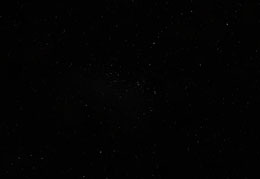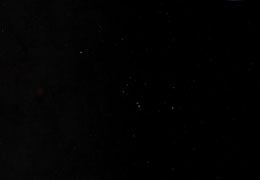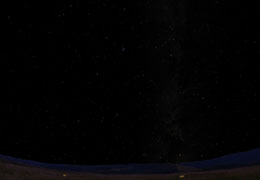There are three types of
star clusters:
open,
globular, and apparent.
Globular clusters contain tens of thousands of
stars and generally exist surrounding the core of
our galaxy - this area is called the Halo, and is typical of spiral galaxies. This makes them hard to see without a
telescope.
Open clusters exist within
our galaxy and can
sometimes be viewable without a
telescope or
binoculars. Here are some examples:
 |
The Pleiades, an open cluster on the right, looks
like a mini-little dipper. On the left is
Taurus, the center of which looks like an open cluster.
This is an
asterism called Hyades. This can also be called an 'apparent' cluster. |
| The Perseus double-cluster is a bit
smaller and harder to see than the above
open clusters, but worth looking for. |
 |
The third type of cluster is not really a
physical cluster, it just looks like one from
Earth.
An example is Hyades within the constellation Taurus
- see the first image above. These types of
"clusters" can be very dramatic as they can contain
stars of various colors (it is common for
stars of a
real cluster to sometimes be identical in color,
like the Pleiades).
Back to Top
M42 - The Orion
Nebula:
The constellation Orion is probably the most
recognized constellation in the
night sky. It
covers a pretty large area, and has
stars of a
variety of sizes and colors. An example is
Betelgeuse, the bright red
star on the upper left of
the constellation - bottom right for those in the
southern hemisphere.
There are three bright
stars that make up the
belt, and some bright
stars almost perpendicular to
the belt - the sword.
 |
Can you see the "cloudy"
star within the
sword of Orion? If you do, you are looking at
M42 - the Great Nebula in Orion. |
The image above is from Starry Night, planetarium
software, but shows Orion as one would see from dark
skies. Can you see the nebula? I will leave you with
the challenge.
Back to Top
M31 - The
Andromeda Galaxy:
The
Andromeda Galaxy (M31) is the closest large
galaxy to the
Milky Way. It is also the only
galaxy
(not including the
Large and Small Magellanic
clouds) that can be seen with the eye.
It is 2.2 million light years away - so it takes
light 2.2 million years to reach
Earth. Even though
it is so far, it still covers an area of sky greater
than a full
Moon!
 |
The
Andromeda Galaxy is in the
constellation Andromeda. It can be hard to
see in this Starry Night image, but this is
how it can be seen from dark skies. Just
look for the cloudy oval. |
As with the Orion nebula, I will not give away
the location of M31. If you can see it here, you
will be able to see it for real from a dark sky
location.
Back to Top
|

